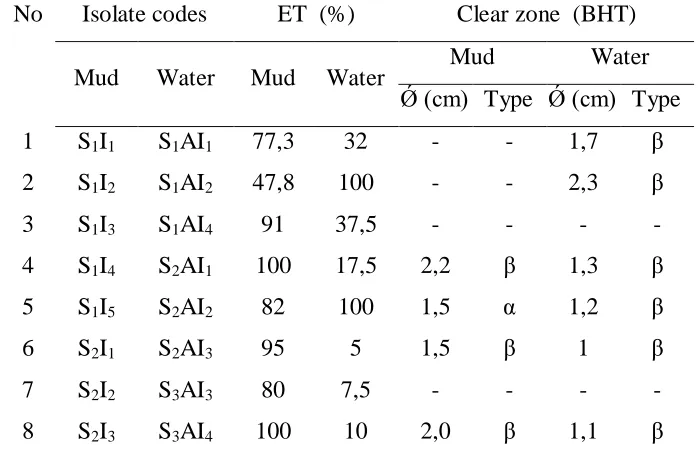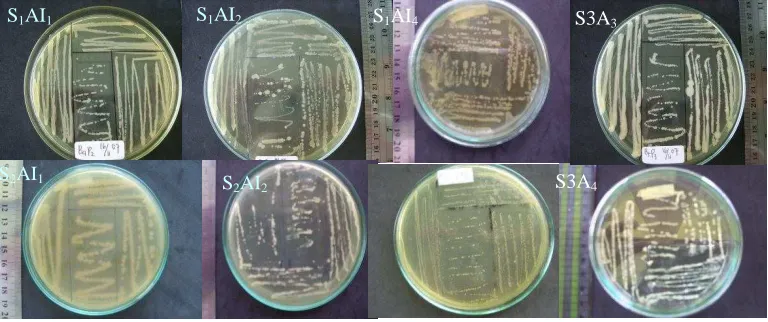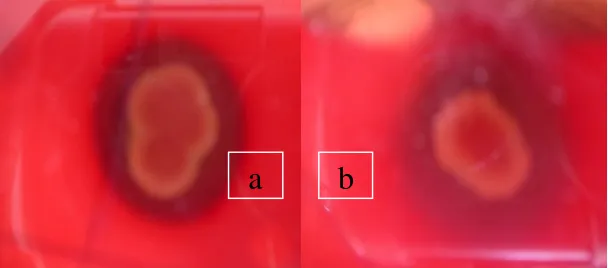ISOLATION OF BIOSURFACTANTPRODUCER BACTERIA FROM CENTRAL MUD TREATMENT FACILITY (CMTF)
PT. BUMI SIAK PUSAKO, RIAU PROVINCE
M.HASBI,WINDARTI, TETTY MARTA LINDA, WIWIK WIDIARTIDANZULFAHANUM
Laboratory of Waste Treatment Management, Aquatic Resources Management Department,
Fishery and Marine Science Faculty, Riau University, Pekanbaru, Indonesia
e-mail: Hasbi_kfupm@yahoo.com
ABSTRACT
A study aims to find out and isolate biosurfactant producer bacteria originated from the Central Mud Treatment Facilities of the PT. Bumi Siak Pusako, Riau has been conducted by the end of 2008. Bacteria samples were isolated from mud and water samples. Sampling was conducted at once, in 2 sampling sites. The bacteria were then cultured using TSA, blood agar and MSM media. The presence of biosurfactant was tested using a Haemolysis Blood Agar Test (HBAT) and Index Emulsification Test (IET). Results is shown that there were 16 isolates, 8 in the mud and the other are in the water samples. Results of the IET indicate that all isolates have various level of biosurfactant production. There are 4 isolates that have 100% IET values, namely S1AI2 andS2AI2originated from water sample and
S1I4 and S2I3 originated from soil sample. Using the HBAT, however, only 5
isolates from soil sample and 6 isolates from water sample shown biosurfactant production. It can be concluded that the IET method is more accurate to detect bacteria that are able to produce biosurfactant.
Key words: biosurfactant, mud treatment, oil waste, Index Emulsification Test
INTRODUCTION
Natural oil is a potential energy resources that is crucial for human life,
especially for industrial needs, transportation and household activities (Kadarwati
et al, 2004). Exploring the natural oil, however, may create environmental related
problems as oil spill is negatively affect the environment (Verania, 2002). To
reduce the risk of oil related pollution and to maintain the natiral resources, a
proper environmental management should be applied
During this decade, handling of oil pollution has been conducted using
several method. However, the methods applied may create another problem. For
(Ni’matuzahroh et al, 2006). The use of biosurfactant is a better alternative in
handling the oil pollution, as it is naturally producad by bacteria, low toxicity,
biodegradable, naturally present in the environment and it can be obtained
cheaply (Kosaric,1992).
Suryatama (2006) stated that addition of Azotobacter chroococcum , a
surfactant producer bacteria increase 54.98% of hydrocarbon biodegradation
eficiency. Ni’matuzahroh et al (2006) proved that Pseudomonas aeruginosa IA7d
biosurfactant increase the petrolium biodegradation in the Tanjung Perak harbor,
Surabaya, it is 67.5 % higher than that of the synthetic surfactant Tween-80.
Bodour et al (2004) conduct a emulsification test toward kerosene and achieve
100% of Emulsification Index.
Efforts to find out and isolate a new strain of biosurfactant producer has
been conducted. Agustiani (2004) found 23 species of thermophylic isolates in the
oil wells in Rumbai Riau. Among these isolates, 15 of them showing haemolytic
activities and 12 of them are biosurfactant producers. Another study, Urum et al
(2004) also proved that rhamnolipid bacteria is able to clean 80% of crude oil spill
in the land. Kofli et al (2000) that used Bacillus macerans strain TS9-8 originated
from PETRONAS Malaysia oil field (Murni, 1998) find out the optimum
concentration of glycerol that can be used as carbon resources for biosurfactant
producers, it is 2% of total media.
Riau Province is a potential oil resource in Indonesia, however, there is few
information on biosurfactant producer bacteria originated from this area, from the
oil wells as well as from the Dumai harbor that is polluted by oil industrial related
waste. In order to find out and to isolate biosurfactant producer bacteria, this study
is conducted. Bacteria samples were collected from in the Central Mud Treatment
Facility (CMTF) of PT.Bumi Siak Pusako (one of oil companies present in Riau),
MATERIALS AND METHODS Time and place
This research was conducted for 6 months, in the Microbiology
Laboratory, Biology Department, Math and Science Faculty, Riau University,
Pekanbaru, Riau.
Materials and methods
Equipments used in this study are: glassware, inoculating lope, Bunsen
burner, oven, autoclave, shaker, vortex, microscope, incubator, hot plate,
micropipette, aluminum foil, cotton and cotton cloth. While materials used in this
research are Tripton Soya Agar (TSA) (Merck), Blood Agar (Merck) and Mineral
Salt Medium (MSM) media and kerosene.
Sampling
100 grams of mud/ soil and 100 grams water that are contaminated with
oil pollutant were taken from 2 waste disposal ponds located in the Central Mud
Treatment Facility (CMTF) of PT.Bumi Siak Pusako, Riau. In each pond, there
were 3 sampling points, but the samples were kept in altogether in a sterile glass
bottle (composite sample) and it is refrigerated (4◦C) prior to bacteria isolation.
Bacteria culture media preparation
In this research, there are 3 types of media used, namely Tripton Soya
Agar (TSA) (Murni, 1998) as a selective media, Blood Agar Media for bacteria
screening and it is used to screen bacteria with blood haemolysis ability. During
the media sterilization process, defibrinated lamb blood is added when this media
reach 45C (Jenning et al, 2000). Mineral Salt Medium (MSM) is used for
fermentation process. The composition of this media is NH4NO3 0,05 g, KH2PO4
0,03 g, Na2HPO4 0,04 g, MgSO4, CaCl2, FeSO4, Na2 EDTA, Yeast extract 0,1 %,
and glycerol 2 % (Cooper et al, 1981; Kofli et al, 2000).
Bacteria isolation
For bacteria isolation, 1 gram of mud or 1 ml of water sample was added
with 10 ml of sterile NaCl 0,85 %. The liquid was then mixed (homogenized
using a vortex) and was diluted into 10-4. 10-3 and 10-4 diluted samples were then
temperature for 24 hours. To get single strain, each bacteria colony present was
isolated and cultured in TSA media and were kept in the refrigerator.
Fermentation preculture preparation
An inoculum of pure/ single strain isolate was grown in the 50 ml of
MSM. This culture was then kept in the incubatorshaker at room temperature,
200 rpm for 24 hours. Population of bacteria colony was then counted. This
pre-culture was then used for fermentation inoculum (Tabatabaee et al 2005).
Preparation for Emulsification Test
1 ml of pre-culture was added into 50 ml of MSM liquid that is kept in the
250 ml Erlenmeyer flask. This liquid was then shake in room temperature (200
rpm) for 3 days (Tabatabaee et al 2005). This culture is then used for
Emulsification test.
Screening of biosurfactant producer bacteria
There are 2 methods applied to identify the biosurfactant producer bacteria,
namely 1) Haemolysis Test: using a Blood Agar media. Bacteria isolate that has
ability in blood haemolysis is predicted to have ability in producing biosurfactant
(Jenning et al, 2000). 2) Emulsification test: the ability of producing biosurfactant
is predicted based on the 24 hours Emulsification Index (IE24) and it can be
counted by using a Cooper and Goldenberg (1987) formula. High IE24 value
means high biosurfactant produced.
Data analysis
Data were obtained by dividing bacteria into 2 groups, the biosurfactant
producer and non biosurfactant producer. Data were analyzed descriptively.
RESULTS AND DISCUSSION Results
Bacteria isolation
Pure bacteria strain obtained from mud and water samples were coded and
presented in Table 1, Figure 1 and Figure 2. There were 16 isolates found, 8 from
Table 1. Isolated Bacteria Strain from Mud and Water Samples,
Based on Emulsification Test (ET) and Blood Haemolysis Test (BHT)
No Isolate codes ET (%) Clear zone (BHT)
Mud Water Mud Water Mud Water
Ǿ (cm) Type Ǿ (cm) Type
1 S1I1 S1AI1 77,3 32 - - 1,7 β
2 S1I2 S1AI2 47,8 100 - - 2,3 β
3 S1I3 S1AI4 91 37,5 - - - -
4 S1I4 S2AI1 100 17,5 2,2 β 1,3 β
5 S1I5 S2AI2 82 100 1,5 α 1,2 β
6 S2I1 S2AI3 95 5 1,5 β 1 β
7 S2I2 S3AI3 80 7,5 - - - -
8 S2I3 S3AI4 100 10 2,0 β 1,1 β
Note : S= Sampling site, Number: number of sampling site … ; I= Isolate,
Number: isolate number …;
A: water β = clear ; α = green ; - = negative
Figure 1.Bacteria Isolates from Mud Sample
S1I2 S2I2 S1I1
S2I1 S1I5
S2I3
S1I4
Figure 2.Bacteria isolates from water sample
Selection of Biosurfactant producer bacteria
Selection of biosurfactant producer bacteria was conducted by 2 different
tests, namely the Emulsification Test (ET) and Blood Haemolysis Test (BHT).
The ET is more specific in selecting the biosurfactant producer bacteria, but the
BHT is the most simple test to detect bacteria that has ability in producing
biosurfactant (Jennings dan Tanner, 2000).
a. Blood Haemohysis Test (BHT)
This method aims to find out bacteria that has ability in blood haemolysis.
The haemolysis activity is identified by the presence of clear zone around the
colony and this zone is used as a basis to predict the ability of bacteria in
producing biosurfactant (Chamanrokh et al, 2008). In this study, 4 isolates from
mud sample and 6 isolate from water samples showing clear zone around the
bacteria colony (Table 1)
b. Emulsification Test (ET)
Even though the ET process is more complicated than that of the BHT, it
is able to provide more accurate results. In this method, all of bacteria isolates
were fermented and then shake (200 rpm) for 3 x 24 hours prior to emulsification
test. Results of ET are presented in Table 1. Different from that of the BHT, the
results of ET shown that all of bacteria tested, from mud and water samples, have S1AI1 S1AI2 S1AI4
S2AI1
S2AI1
S2AI1
S2AI1 S
2AI2 S2AI3 S3AS3AI4 1
ability in producing biosurfactant. The potential in producing biosurfactant,
however, is various, as it is indicated by different level of biosurfactant produced.
Discussion
The number of bacteria isolates
The number of bacteria isolated from the mud and water samples is 16, 8
from each sample. Compare to a prior study, the number of bactaria isolated in
this study is relatively low, Agustiani (2004) isolate 23 bacteria strains. This
difference may be caused by the difference of physical factors applie during
bacteria culture in the laboratory. Agustiani (2004) incubated the bacteria in the
50◦C , a temperature that relatively same with the Rumbai’s oil wells temperature
where the sample was taken. In this study, however, the sample was taken from
the area that have relatively high temperature (40 ◦ C), but the bacteria was
incubated in room temperature (25 – 28 ◦ C). Due to this temperature difference,
several specific bacteria may not be able to grow and as a result, the number of
bacteria isolated is relatively low.
Selection of biosurfactant producer bacteria
Blood haemolysis Test (BHT)
Result of the HBT is showing that 4 isolates have clear zone around the
each colony. Diameter of the S1I4 isolate is 2.2 cm, S2I3 is 2 cm, S2I1 is 1.5 cm
and that of the S1I5 is 1.5 cm. S1I4, S2I3 and S2I1 isolates are grouped as beta
haemolysis, as they are able to haemolyse all of red blood cells present in the
media (Figure 2. a.). S1I5 isolate, however, is belonged to alpha haemolysis, as it
is not able to haemolyse all of red blood cells available, as it is indicated by the
presence of green zone around the colony (Figure 2. b.). The green color present
as there is biliverdin that is formed when red blood cells are degraded (Anonim,
2007). Four other isolates are not able to haemolyse red blood present in the
media, and they are grouped as “non haemolytic bacteria”.
Results of water sample test indicated that 6 bacteria isolate shown
positive signs. It means that these isolates may potential as biosurfactant
clear zones are 1.7; 2.3; 1.3; 1.2; 1; and 1.1 cm respectively. Two other isolates,
however, are not potential for biosurfactant producers, they are S1AI4 and
S1AI3..Based on clear zone color, the biosurfactant producers bacteria isolated
from the water sample can be categorized beta haemolysis, as they are able to
degrade all of blood present in the media (Figure 2.).
Figure 3. (a) Beta haemolysis, (b) alpa haemolysis
According to Daud et al (2005) from Malaysia, the betha haemolysis
bacteria may have high potential as biosurfactant producers. Ni’matuzahroh
(1999) also proved that the betha haemolysis bacteria such as Pseudomonas sp.
obtained from Surabaya waters is potential for biosurfactant producer. Moreover,
Agustiani (2004) stated that among the 15 haemolysis positive isolates, 12 of
them are biosurfactant producers. On the other hand, bacteria that is showing no
haemolysis activity, may not be able to produce biosurfactant.
Even though 4 isolates shown haemolysis positive, other tests need to be
conducted in order to prove the ability of the bacteria in producing the
biosurfactant. Youssef et. al. (2004) stated that the HBT shown less correlation
with reducing tegangan permukaan. So, the BHT method may not be sufficient for
detecting the biosurfactent producer bacteria.
b.Emulsification Test (ET)
As presented in Table 1, results of the ET are different with that of the
HBT. All isolates that are tested using ET method is shown positive signs or it
means that all of isolate are able to produce various level of biosurfactant. The
amount of stabile emulsion formed indicates the amount of biosurfactant
S1I4and S2I3 originated from mud sample and S1AI2and S2AI2 isolate from water
sample. It means that all of hydrocarbon in the media can be emulsified properly.
Results of the BHT and ET are showing that they produce different results.
Several previous studies indicates that haemolysis method may be used as a basis
to early prediction of biosurfactant producer bacteria (Fatimah, 2007),
(Tabatabaee, A. et. al, 2005). However, results of this study indicate that isolates
with positive HBT results, may not produce biosurfactant. In contrast, isolate with
negative BHT result may produce higher biosurfactant than those with positive
result. So, it is clear that the Haemolysis can not be used as a basis to identify the
biosurfactant producer bacteria. Similar results also found by Youssef, et al.
(2004). To understand the exacts concentration of biosurfactant produced by
bacteria, biosurfactant extraction should be conducted.
CONCLUSION AND SUGGESTION
Conclusion
1. There are 16 bacteria strain found in the mud and water samples obtained
from Central Mud Treatment Facilities of the PT. Bumi Siak Pusako, Riau.
Eight strains are found in each sample.
2. Results of 24 hours Index Emulsification Test (IE24 ) shown that all of
bacteria identified have various level of biosurfactant production. Four
strains showing 100% of IE24, they are S1AI2 and S2AI2 (from water
sample) and S1I4 and S2I3 (from mud sample).
3. Blood Haemolysis Method may not sufficient for detecting biosurfactant
producer bacteria. However, isolate with beta (β) positive result are able
to produce biosurfactant.
Suggestion
As there are four isolates potential for producing biosurfactant and
biosurfactant detection in this study is conducted by qualitative method only, a
quantitative test should be conducted for detecting the concentration of
REFERENCES
Agustiani, E.D., 2004. Skrining Bakteri Penghasil Biosurfaktan dari Sumur
Minyak Bumi di Rumbai Riau (Abstrak).http.www.itb.ac.id/library.
[Accessed Date 15 September 2007].
Anonim. 2007. Biosurfaktan. http//www.google.com [Accessed Date 2 Agustus
2007]
Chamanrokh P., Assadi M. M., Noohi A., Yahyai., 2007, Emulsan Analysis
Produced By Locally Isolated Bacteria and Acinetobacter calcoaceticus
RAG-1, Iran Journal Environtmental Health Scient Engineering 5(2):
101-108
Cooper, D.G., Macdonald, Duff, S.J., Kosaric, N., 1981. Enhanced Production of
Surfactin from Bacillus subtilis by continuous Product Removal and
Metal Cation Additions.Applied and Environmental Microbiology. 42
(3): 408-412
Jennings, E.M, Tanner, R.S., 2000. Biosurfactant Producing Bacteria Found in
Contaminated and Uncontaminated Soils. Procceding of the 2000
Conference on Hazardous Waste Research. Van Vleet Oval, Norman.
1-8.
Kadarwati, S., Rahayu, S.A., Sugihardjo., 2004. Studi Aktivitas Mikroba untuk
proses MEOR Skala Laboratorium. Buletin. Lembaran Publikasi
LEMIGAS. 38.
Kosaric, N., 1992. Biosurfactants in Industry.Pure & Applied Chemical Journals.
64 (11): 1731-1737
Koflli, N.T., Rahman, R.A., Hasbi, M., Kalil, S. 2000. Fermentation by Bacillus
macerans Strain TS9-8 for Biosurfactant Production.Pure & Applied
Chemical Journals.1429-1437.
Murni, M.M.M., 1998. Isolation of Biosurfactant Producing Bacteria and
Characterization of The Biosurfactant Produced by one of The Isolates.
Ph.D. Thesis. Universiti Kebangsaan Malaysia, Bangi, Selangor
Biodegradasi Solar oleh Mikroba Perairan Pelabuhan Tanjung Perak
Surabaya. Penelitian Hayati. 12: 13-18.
Suryatama, P., 2006. Biodegradasi Hidrokarbon Minyak Bumi dengan
Penambahan Azotobacter chroococcum AC04 sebagai bakteri penghasil
biosurfaktan (Abstrak). Di dalam: Sidang Terbuka Program Doktor;
Bandung, 4 Oktober 2006. Program Pasca Sarjana ITB, Bandung.
Tabatabaee. A., Assadi. M.M., Noohi. A.A., Sajadian, V.A., 2005. Isolation of
Biosurfactant Producing Bacteria from Oil Reservoirs.Iranian Journal
Environment Health Science Engginering. 2: 6-12.
Urum, K., Pekdemir, T., 2004. Evaluation of Biosurfactants for Crude Oil
Contaminated Soil Washing. Chemosphere 57: 1139-1150
Verania.2002. Pengaruh Variasi Jumlah Bakteri Penghasil Biosurfaktan dari
Bakteri Pendegradasi terhadap Biodegradasi Limbah Minyak Bumi
(Abstrak). Research Report dari JIPTUNAIR. 26-10-2004.
Youssef, N H., Duncan, K. E., Nagle, D. P., Savage, K.N., Knapp, R. M.,
McInerney, M. J.,2004. Comparison of methods to detect biosurfactant
production by diverse microorganisms.J Microbiol Methods. 2004;56


